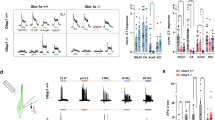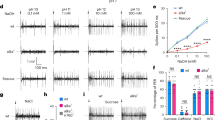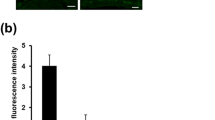Abstract
Sour taste is initiated by protons acting at receptor proteins or channels. In vertebrates, transduction of this taste quality involves several parallel pathways1,2,3,4,5. Here we examine the effects of sour stimuli on taste cells in slices of vallate papilla from rat. From a subset of cells, we identified a hyperpolarization-activated current that was enhanced by sour stimulation at the taste pore. This current resembled Ih found in neurons and cardio-myocytes6,7, a current carried by members of the family of hyperpolarization-activated and cyclic-nucleotide-gated (HCN) channels8,9,10,11,12,13. We show by in situ hybridization and immunohistochemistry that HCN1 and HCN4 are expressed in a subset of taste cells. By contrast, gustducin, the G-protein involved in bitter and sweet taste14, is not expressed in these cells. Lowering extracellular pH causes a dose-dependent flattening of the activation curve of HCN channels and a shift in the voltage of half-maximal activation to more positive voltages. Our results indicate that HCN channels are gated by extracellular protons and may act as receptors for sour taste.
This is a preview of subscription content, access via your institution
Access options
Subscribe to this journal
Receive 51 print issues and online access
$199.00 per year
only $3.90 per issue
Buy this article
- Purchase on Springer Link
- Instant access to full article PDF
Prices may be subject to local taxes which are calculated during checkout




Similar content being viewed by others
References
Gilbertson, T. A., Avenet, P., Kinnamon, S. C. & Roper, S. D. Proton currents through amiloride-sensitive Na channels in hamster taste cells: role in acid transduction. J. Gen. Physiol. 100, 803–824 (1992).
Kinnamon, S. C., Dionne, V. E. & Beam, K. G. Apical localization of K channels in taste cells provides the basis for sour taste transduction. Proc. Natl Acad. Sci. USA 85, 7023–7027 (1988).
Ugawa, S. et al. Receptor that leaves a sour taste in the mouth. Nature 395, 555–556 (1998).
Miyamoto, T., Fujiyama, R., Okada, Y. & Sato, T. Sour transduction involves activation of NPPB-sensitive conductance in mouse taste cells. J. Neurophysiol. 80, 1852–1859 (1998).
Stewart, R. E., Lyall, V., Feldman, G. M., Heck, G. L. & DeSimone, J. A. Acid-induced responses in hamster chorda tympani and intracellular pH tracking by taste receptor cells. Am. J. Physiol. 275, C227–C238 (1998).
Pape, H. C. Queer current and pacemaker: the hyperpolarization-activated cation current in neurons. Annu. Rev. Physiol. 58, 299–327 (1996).
Trotier, D. & Doving, K. B. Direct influence of the sodium pump on the membrane potential of vomeronasal chemoreceptor neurones in frog. J. Physiol. (Lond.) 490, 611–621 (1996).
Santoro, B. et al. Identification of a gene encoding a hyperpolarization-activated pacemaker channel of brain. Cell 93, 717–29 (1998).
Gauss, R., Seifert, R. & Kaupp, U. B. Molecular identification of a hyperpolarization-activated channel in sea urchin sperm. Nature 393, 583–587 (1998).
Ludwig, A., Zong, X., Jeglitsch, M., Hofmann, F. & Biel, M. A family of hyperpolarization-activated mammalian cation channels. Nature 393, 587–591 (1998).
Santoro, B. & Tibbs, G. R. The HCN gene family: molecular basis of the hyperpolarization-activated pacemaker channels. Ann. N. Y. Acad. Sci. 868, 741–764 (1999).
Santoro, B. et al. Molecular and functional heterogeneity of hyperpolarization-activated pacemaker channels in the mouse CNS. J. Neurosci. 20, 5264–75 (2000).
Kaupp, U. B. & Seifert, R. Molecular diversity of pacemaker ion channels. Annu. Rev. Physiol. 63, 235–237 (2001).
Wong, G. T., Gannon, K. S. & Margolskee, R. F. Transduction of bitter and sweet taste by gustducin. Nature 381, 796–800 (1996).
Monteggia, L. M., Eisch, A. J., Tang, M. D., Kaczmarek, L. K. & Nestler, E. J. Cloning and localization of the hyperpolarization-activated cyclic nucleotide-gated channel family in rat brain. Brain Res. Mol. Brain Res. 81, 129–139 (2000).
DeSimone, J. A., Callaham, E. M. & Heck, G. L. Chorda tympani taste response of rat to hydrochloric acid subject to voltage-clamped lingual receptive field. Am. J. Physiol. 268, C1295–C1300 (1995).
Pittman, D. W. & Contreras, R. J. Responses of single lingual nerve fibers to thermal and chemical stimulation. Brain Res. 790, 224–235 (1998).
Boughter, J. D. Jr, Pumplin, D. W., Yu, C., Christy, R. C. & Smith, D. V. Differential expression of α-gustducin in taste bud populations of the rat and hamster. J. Neurosci. 17, 2852–2858 (1997).
Munsch, T. & Pape, H. C. Modulation of the hyperpolarization-activated cation current of rat thalamic relay neurones by intracellular pH. J. Physiol. (Lond.) 519, 493–504 (1999).
Zong, X., Stieber, J., Ludwig, A., Hofmann, F. & Biel, M. A single histidine residue determines the pH sensitivity of the pacemaker channel HCN2. J. Biol. Chem. 276, 6313–6319 (2001).
Seifert, R. et al. Molecular characterization of a slowly gating human hyperpolarization- activated channel predominantly expressed in thalamus, heart, and testis. Proc. Natl Acad. Sci. USA 96, 9391–9396 (1999).
Striem, B. J., Naim, M. & Lindemann, B. Generation of cyclic AMP in taste buds of the rat circumvallate papilla in response to sucrose. Cell. Physiol. Biochem. 1, 46–54 (1991).
Müller, F. et al. Ligand sensitivity of the α2 subunit from the bovine cone cGMP-gated channel is modulated by protein kinase C but not by calmodulin. J. Physiol. (Lond.) 533, 399–409 (2001).
Acknowledgements
We thank the Deutsche Forschungsgemeinschaft for support.
Author information
Authors and Affiliations
Corresponding author
Rights and permissions
About this article
Cite this article
Stevens, D., Seifert, R., Bufe, B. et al. Hyperpolarization-activated channels HCN1 and HCN4 mediate responses to sour stimuli. Nature 413, 631–635 (2001). https://doi.org/10.1038/35098087
Received:
Accepted:
Issue Date:
DOI: https://doi.org/10.1038/35098087
This article is cited by
-
Nutrigenomics reveals potential genetic underpinning of diverse taste preference of Chinese men
Genes & Genomics (2021)
-
Taste transduction and channel synapses in taste buds
Pflügers Archiv - European Journal of Physiology (2021)
-
Disease-linked mutations alter the stoichiometries of HCN-KCNE2 complexes
Scientific Reports (2019)
-
Taste buds: cells, signals and synapses
Nature Reviews Neuroscience (2017)
-
Electrical resonance with voltage-gated ion channels: perspectives from biophysical mechanisms and neural electrophysiology
Acta Pharmacologica Sinica (2016)
Comments
By submitting a comment you agree to abide by our Terms and Community Guidelines. If you find something abusive or that does not comply with our terms or guidelines please flag it as inappropriate.



